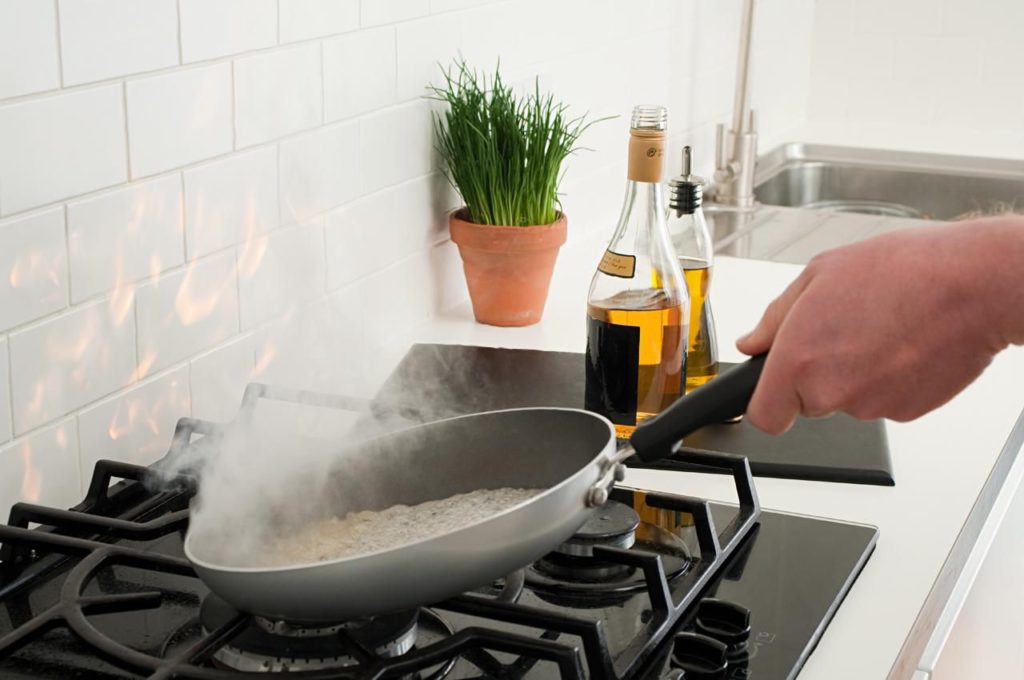- General
- Updated on April 26, 2025
The Hidden Dangers of Non-Stick Pans You Need to Know

Introduction
Non-stick cookware has become a staple in modern kitchens due to its convenience and ease of use. Whether you’re flipping pancakes or frying eggs, the smooth, slippery surface reduces the need for oil and makes cleaning up a breeze. But what if this everyday kitchen tool harbors potential health risks that many are unaware of?
In recent years, concerns have emerged about the safety of certain chemicals used in non-stick coatings, particularly Teflon. When overheated or scratched, non-stick pans may release toxic fumes and particles into the air and food, potentially harming both humans and pets.
In this blog, we’ll uncover the truth about non-stick cookware—what it’s made of, how it works, what the science says, and safer alternatives to consider.
History of Non-Stick Cookware
Non-stick cookware began in 1938 with Roy Plunkett’s discovery of PTFE (Teflon), known for its slick, heat- and chemical-resistant properties. By the 1950s, Teflon-coated pans became popular for easy cooking and cleaning. PTFE’s non-stick nature stems from strong carbon-fluorine bonds. Historically, manufacturing involved PFOA, a toxic chemical linked to serious health risks, now phased out. Modern pans use alternatives like GenX, which may pose similar dangers. Non-stick coatings are applied through roughening the pan’s surface, layering PTFE, and baking. Despite “PFOA-free” claims, concerns about chemical safety persist.
Chemical Compounds and Their Risks
Polytetrafluoroethylene (PTFE), known as Teflon, is valued for its non-stick properties, chemical resistance, and stability under normal cooking conditions. When used below 260°C (500°F), PTFE remains safe. However, overheating can cause it to break down, releasing toxic fumes that may lead to polymer fume fever in humans and fatal respiratory issues in birds. While PTFE itself is relatively safe with careful use, the danger lies in the toxic byproducts produced at high temperatures.
Historically, PTFE manufacturing relied on Perfluorooctanoic Acid (PFOA), a chemical now recognized for its persistence in the environment and serious health risks. Exposure to PFOA has been linked to cancers, thyroid disorders, immune dysfunction, and reproductive problems. Due to these hazards, the U.S. Environmental Protection Agency (EPA) led efforts to eliminate PFOA through initiatives like the 2010 Stewardship Program. Although PFOA has largely been phased out, concerns about its environmental and health impacts persist.
In the absence of PFOA, manufacturers introduced substitutes like GenX, part of the PFAS (Per- and polyfluoroalkyl substances) family. While marketed as safer, early research shows GenX may have similar harmful effects, including liver and kidney damage, reproductive toxicity, and potential cancer risk. PFAS chemicals, often called “forever chemicals,” are troubling because of their persistence in the environment and human body.
Chemical off-gassing from overheated non-stick cookware remains a critical issue. Heating pans beyond 260°C (500°F) can lead to the release of toxic compounds, which are harmful to both humans and animals. Everyday cooking practices, like preheating empty pans, can easily cause these dangerous temperatures.
Ultimately, non-stick cookware offers convenience but demands cautious use. Understanding the risks associated with PTFE, PFOA, PFAS, and chemical off-gassing helps consumers use these products more safely and make informed decisions about their kitchen tools.
Health Hazards for Humans

1. Respiratory Issues from Inhaling Fumes
- Overheating non-stick pans (above 260°C or 500°F) can cause PTFE coatings to release toxic fumes.
- These fumes may irritate the respiratory tract, causing coughing, shortness of breath, or chest tightness.
- Poor kitchen ventilation increases the risk of inhaling harmful gases during cooking.
2. Teflon Flu (Polymer Fume Fever)
- A temporary illness resembling the flu caused by inhaling PTFE fumes.
- Symptoms include fever, chills, headache, body aches, and coughing, usually appearing 4–8 hours after exposure.
- Often misdiagnosed due to its similarity to viral flu, but typically resolves within 48 hours.
- While mild in most cases, it signals exposure to hazardous compounds.
3. Long-Term Exposure Risks
- Prolonged or repeated exposure to fumes and residual chemicals has been linked to serious health issues.
- Studies associate these exposures with kidney and testicular cancers, liver enlargement, and hormonal disruption.
- Reproductive harm, including reduced fertility and developmental effects in offspring, has also been noted.
4. PFAS Exposure and Immune System Damage
- PFAS chemicals, including GenX and legacy compounds like PFOA, are known to suppress immune function.
- Research shows links between PFAS and reduced vaccine efficacy and increased risk of infections.
- These “forever chemicals” accumulate in the body and can persist for years, compounding health risks over time.
5. Risks from Scratched or Damaged Pans
- Scratches or chips in the coating can expose the underlying metal and release particles of PTFE into food.
- Heating damaged pans increases the chance of chemical breakdown and off-gassing.
- Metal utensils and abrasive cleaning tools accelerate wear, heightening potential exposure.
Environmental Concerns – The Hidden Cost of Non-Stick Cookware
Non-stick cookware, once praised for its convenience and easy cleanup, has a darker side when it comes to its environmental impact. The chemicals used in non-stick coatings, primarily per- and polyfluoroalkyl substances (PFAS), have raised significant concerns due to their persistence in the environment and potential to contaminate water supplies.
1. PFAS and Water Contamination
PFAS, often referred to as “forever chemicals,” do not break down naturally in the environment. Over time, they accumulate in water, soil, and living organisms. As these chemicals leach into the water supply, they pose serious health risks, including hormone disruption, immune system damage, and cancer. Studies have found PFAS in drinking water sources across the globe, particularly near manufacturing sites and landfills.
2. Persistence in the Environment
The name “forever chemicals” reflects their resistance to environmental degradation. Once released, PFAS can remain in ecosystems for decades, contaminating water sources and entering the food chain. This long-term persistence has made it challenging for regulators to address PFAS contamination effectively.
3. Manufacturing Waste and Ecological Impact
The production of non-stick cookware involves significant ecological costs. Waste from the manufacturing process can include residual chemicals like PFOA, which pose risks to surrounding ecosystems. Airborne pollution from production facilities can also contribute to environmental contamination.
4. Global Regulatory Responses
Regulatory bodies around the world have started to take action against PFAS contamination. The European Union and the United States, for instance, have implemented or are in the process of introducing regulations to limit PFAS in consumer products. The EPA in the U.S. has also committed to reducing these chemicals in drinking water.
5. The Problem of Non-Stick Cookware Disposal
When non-stick pans are disposed of, the coating can release harmful chemicals into landfills and incinerators. Proper disposal methods and recycling efforts for non-stick cookware remain limited, exacerbating environmental damage.
Also Read: The Impact of Artificial Intelligence on Various Industries in India
What to Look for in “Safe” Cookware
Cookware labeled “PFOA-free” or “eco-friendly” can be misleading, as these terms don’t always ensure safety or sustainability.
- PFOA-free: This label means the cookware is made without perfluorooctanoic acid (PFOA), a harmful chemical once used in non-stick coatings. However, many products replace PFOA with other potentially dangerous chemicals, such as GenX, which still pose health and environmental risks.
- Eco-friendly labels: These are often vague and sometimes a form of greenwashing. Just because a product is labeled as eco-friendly doesn’t mean it was made sustainably or without harmful chemicals. For cookware to be truly eco-friendly, it should be made from durable, sustainable materials with minimal environmental impact.
- Ceramic Coatings: Ceramic cookware is often marketed as safer, free from PTFE and PFOA. While generally free of toxic chemicals, ceramic coatings can wear down over time, exposing underlying metal, which may be harmful.
- Anodized Aluminum & Stainless Steel: These materials are safer alternatives to non-stick cookware. Anodized aluminum forms a hard, non-reactive surface, while stainless steel is durable and non-toxic. However, their production processes can still have environmental impacts.
- Evaluating Non-toxic Cookware: Truly non-toxic options include stainless steel, cast iron, carbon steel, and high-quality ceramic, which are durable and free from harmful chemicals when used correctly.
In summary, while labels like “PFOA-free” and “eco-friendly” may sound reassuring, they don’t guarantee safety. Choosing cookware made from natural, non-toxic materials like stainless steel, cast iron, or ceramic is a safer and more sustainable option.
Conclusion
Non-stick pans offer undeniable convenience, making cooking and cleaning easier. However, as we’ve explored, they come with significant health and environmental risks that often go unnoticed. From the release of toxic fumes when overheated to the long-term impact of chemicals like PFOA and PFAS, non-stick cookware can present serious concerns, especially when improperly used. Overheating, scratching, or damage to these pans can increase exposure to harmful substances, potentially leading to respiratory issues, immune system disruption, and other long-term health problems.
As consumers, it’s important to be informed about the materials we use in the kitchen. While newer alternatives like ceramic-coated, anodized aluminum, or stainless steel offer safer options, understanding what truly makes cookware “safe” is key. Labels like “PFOA-free” or “eco-friendly” are often misleading, and greenwashing practices in cookware marketing can create a false sense of security.
Ultimately, making safer choices in the kitchen requires a careful evaluation of materials, understanding the potential risks, and opting for non-toxic, durable cookware like stainless steel, cast iron, and high-quality ceramic. By being mindful of the cookware we use, we can better safeguard our health and the environment, all while maintaining the convenience and efficiency that non-stick pans promise.
Join the discussion
Related Articles
No results available
ResetTrending Articles


- General
- Updated on December 27, 2025


- General
- Updated on December 22, 2025


- General
- Updated on December 20, 2025


- General
- Updated on December 16, 2025


- General
- Updated on December 15, 2025


- General
- Updated on December 11, 2025


- General
- Updated on December 11, 2025


- General
- Updated on December 11, 2025


- General
- Updated on December 2, 2025


- General
- Updated on December 5, 2025
No results available
Reset


